
Annli Basedahl
Keywords: Coexistence, Textiles, Makingkin
Internship: Meyers & Fügmann
Research based textile designer, embracing an experimental approach, with a focus on restoring our relationship with the matter surrounding us
GROWING TOGETHER + VERY FOND OF EACH OTHER
Graduation Project
For as long as I can remember I love to create with my hands. Textiles have enabled me to build a direct connection between craft, materials, my surroundings and myself. In a society where many have lost touch with textiles, garments and their environment, I want to create work that makes others question this lost connection and try to rebuild it. Many things carry far more value than what most humans prescribe them. My research in textile design aims for long-term appreciation and care. I believe in the possibility of revaluation and respecting materials or objects, the same way we should respects all other forms of life. Both the disconnection of humans and nature as well as the interconnectedness of all beings intrigue me. Donna Haraway’s idea of kin making helped me to understand the importance to live and create with meaning. Making kin is about all the relations to whom one is actually responsible and creating different kinds of relationships than what we are used to. Haraway states that any kind of relation also correlates with obligation and accountability. Aspects like this influence and reflect in my practice. As a research driven textile designer it is important for me to understand the fibres and other materials that I use. For Growing together + very fond of each other I search for a deeper connection to the natural and tactile matter in my immediate surroundings. I try to find a way to create with nature as a partner and start a conversation with her. At first I picked up all kinds of different discarded natural materials. Reworking, connecting and stitching them with my hands created a kind of intimacy. For my investigation I eventually chose to set a closer focus on just one thing: the onion. I wanted to understand her qualities through handling in different ways. This process built up a relation, between the materials and myself. The continuous examination of an ordinary onion and her manifold variations made me sharpen all senses and brought a deep connection with my immediate surroundings. Growing together + very fond of each other is an in-depth confrontation with the materials that I investigate and a revaluation and appreciation of their presence, their qualities and the way in which we interact. At the same time I hope my project triggers the viewer to create own meaningful and caring relationships and support further connection to their more-than-human surroundings. The onion acts as a sensitive mediator of these ideas. I am trying to free myself from the ready-to-use end product, which makes my onion materials a playful interaction. I am floating in-between the fields of textile art, craft and design with my project as well as my practice. I would like to continue material research and development in the future, because I believe that meticulous investigations in textile design contribute to a meaningful interaction with the natural world.
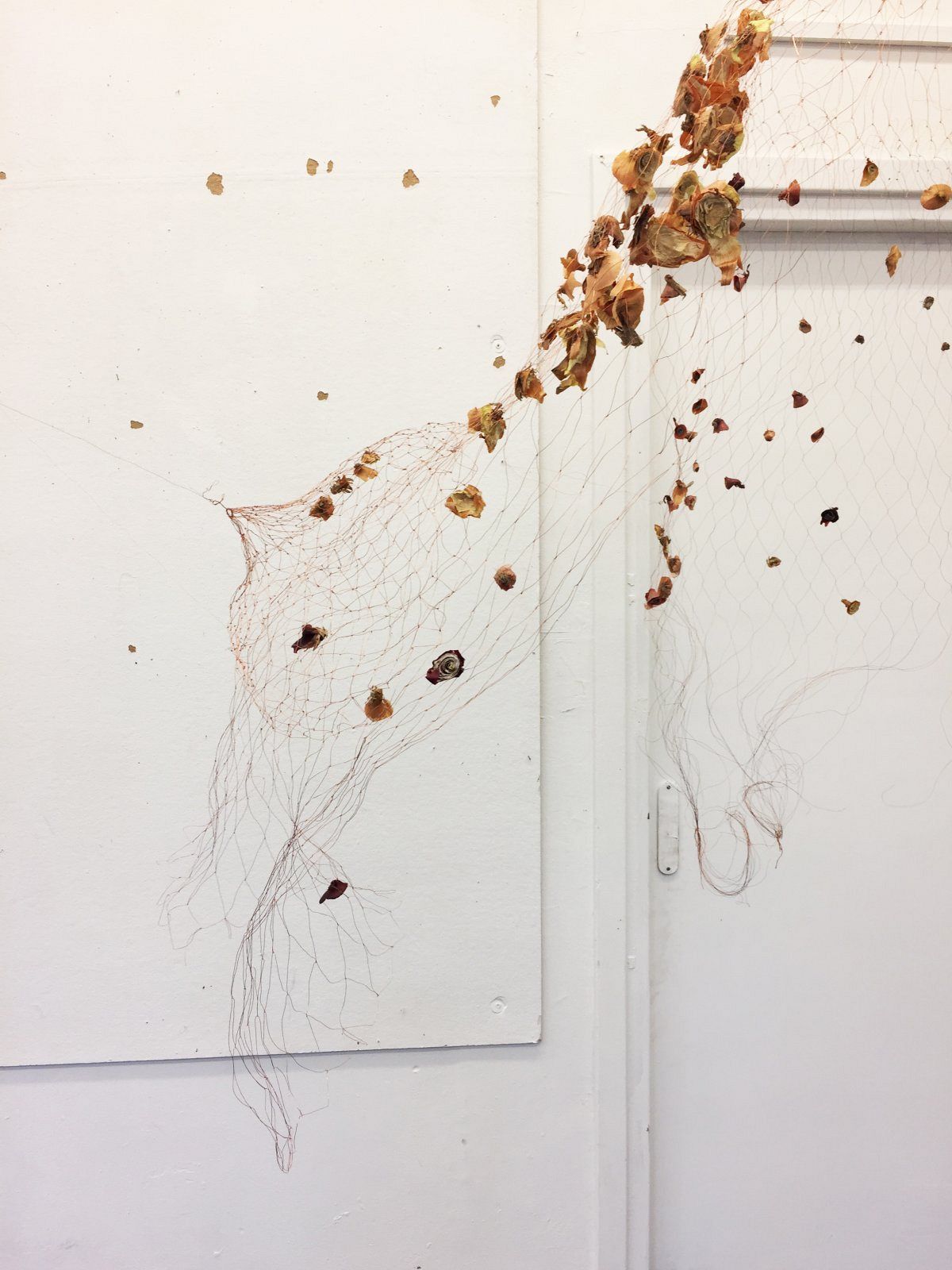
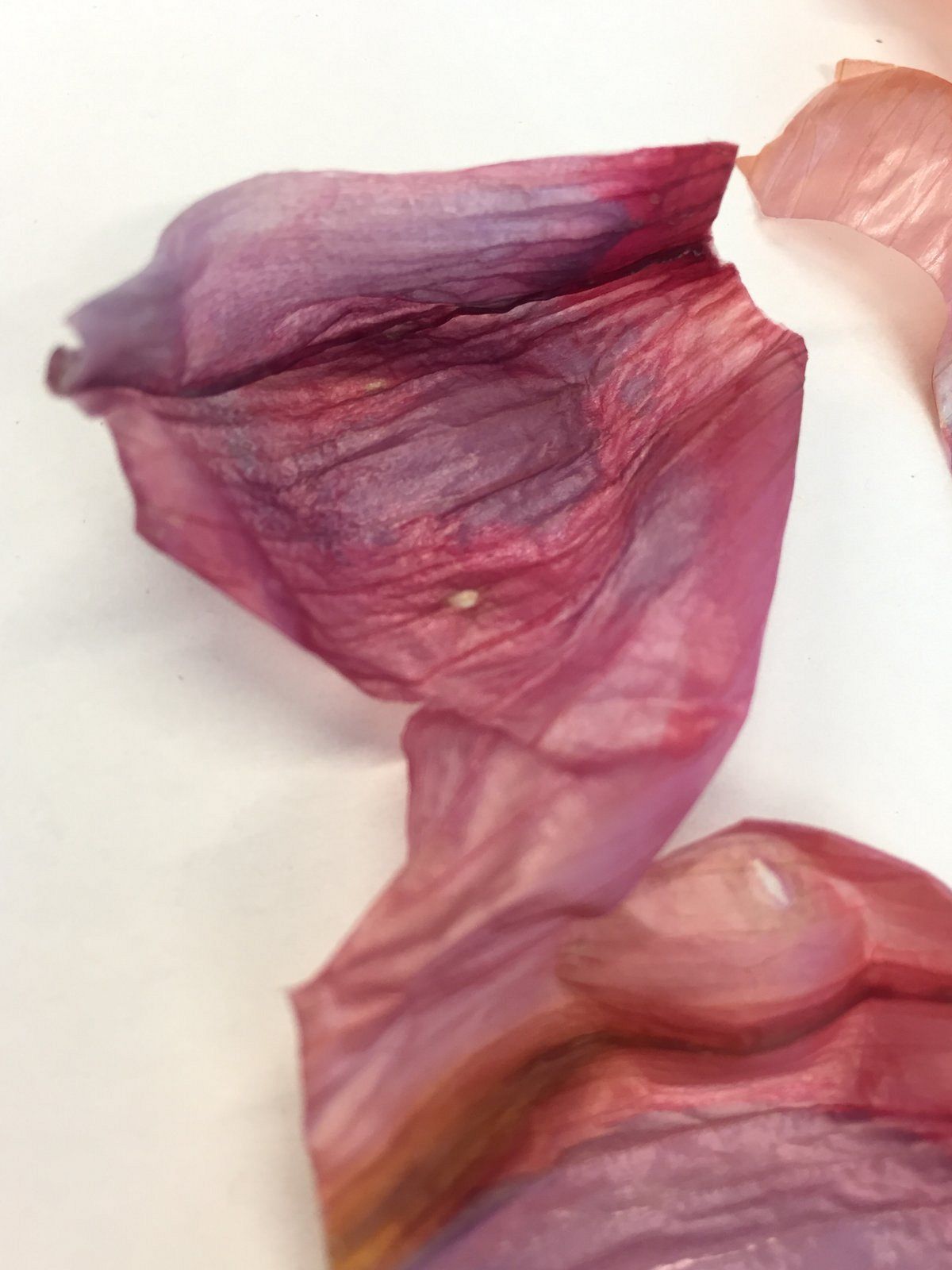



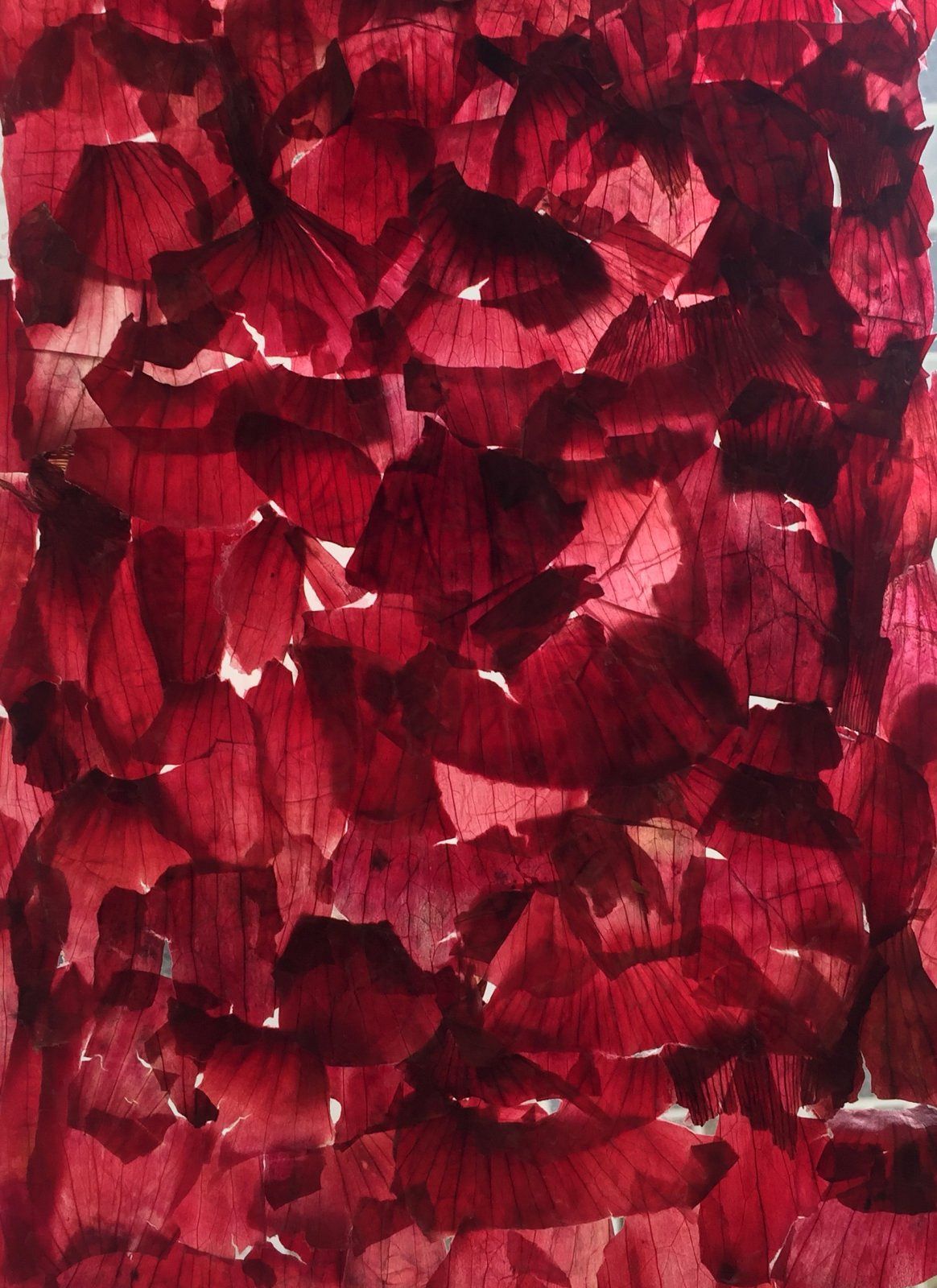
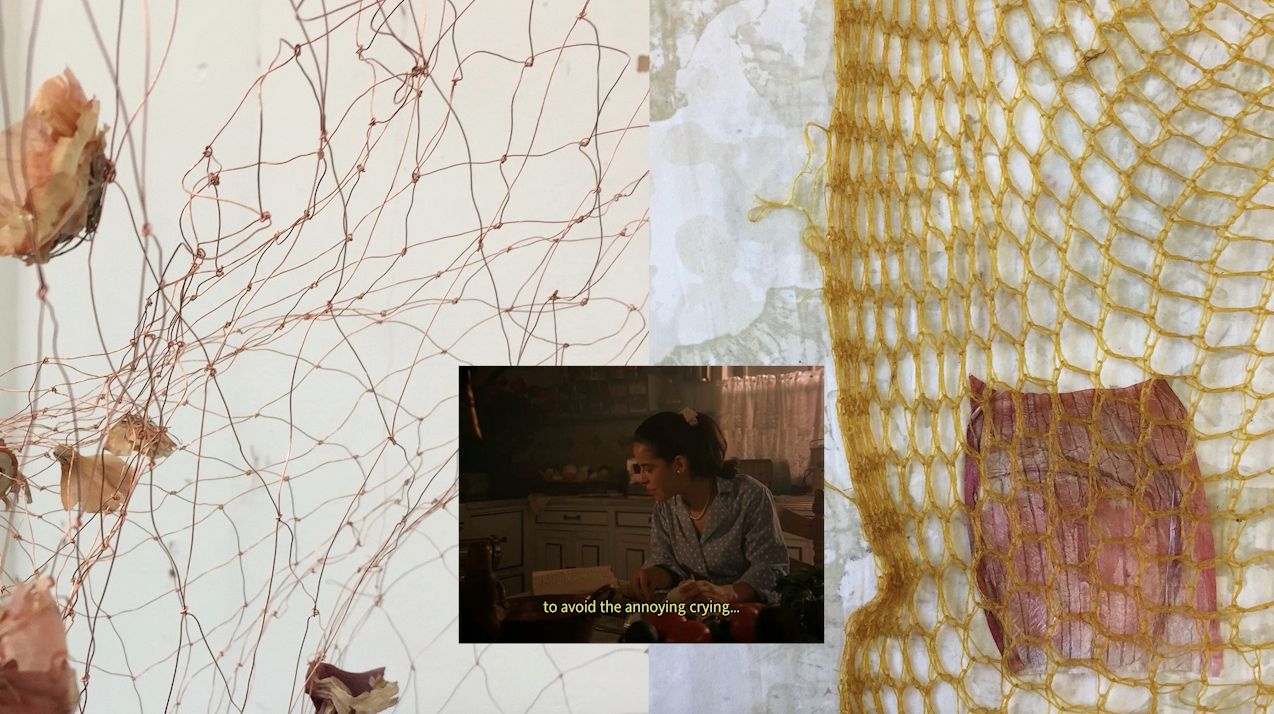
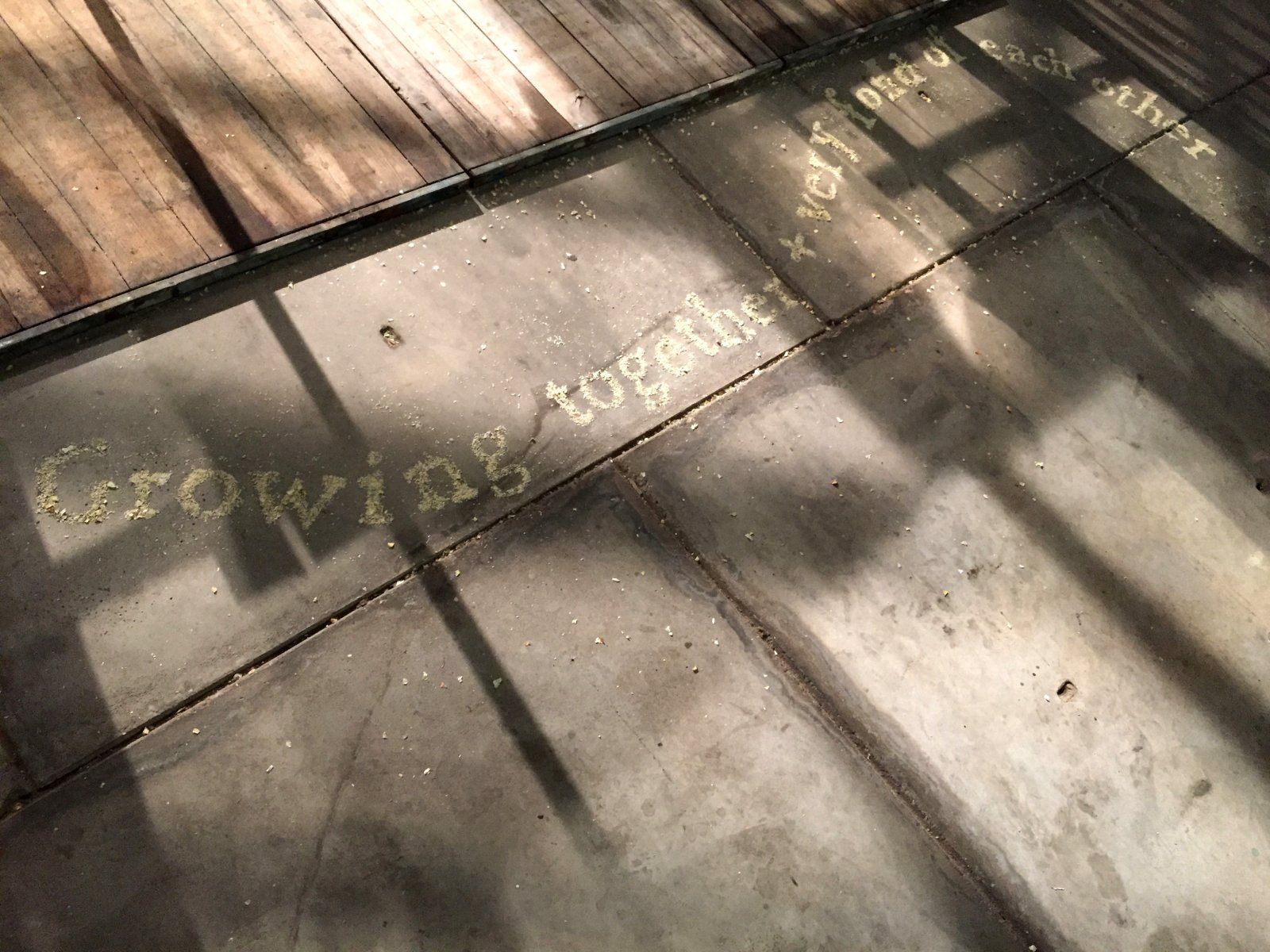

GROWING TOGETHER + VERY FOND OF EACH OTHER
Thesis
Introduction
More than ever the past year and the pandemic have shown us how entangled we are in this volatile world. For the first time in a very long time the Covid-19 lockdowns all over the world forced us to pause, slow down and think. This uncertain but also precious time made us aware how unconsciously we stumbled through our everyday lives and perhaps showed us a little glimpse of what a life with a little slower pace could feel like. Nature and wild life seemed to enjoy the small break from excessive human interventions. The pandemic reminded us about the importance of caring for ourselves and for others. At the same time our longing to get out into parks, forests, mountains, dunes or just to walk around the neighbourhood intensified from day to day. For me being outside and wandering through the parks in the city brought forth the awareness of how disconnected humans are from the rest of the natural world and all its inhabitants. As a textile student I have been thinking about this disconnection for a while, often questioning the use of unsustainable materials that had little to do with the sensitivity of textiles that had led me onto the path to study textile design. At this point I want to mention that this research is mostly referring to Western developments and concepts of design, where the disconnection from humans and nature is undeniable, whereas there are many peoples and other cultures that have always lived in very close connection and harmony with the natural world and continue to do so (Mohanty 2021).
In 2019, sustainable and medical design researcher Louise St. Pierre argued that humans rest in their position on top of the hierarchy. The environment and most living creatures are facing endangerment through global warming, destruction of natural habitat, mass extinction - and the list goes on. It is clear that something has to change. While researching and reflecting on changing our approach for saving the planet, I repeatedly had to remind myself that it counts for human survival too. This realisation shows ridiculously clearly how apart many of us humans see ourselves from the natural world. As nature documentary filmmaker David Attenborough puts it, no matter how devastating our malpractices, nature will prevail (2020). Facing challenges like these, also urges designers to question their input and consequences of their design practices. Kate Fletcher, sustainable pioneer, activist and professor at the Centre of Sustainable Fashion at University of the Arts in London, proposes that old traditions have to give way for a new bonding between nature and design (2019). She notes that approaching design from different perspectives, including new practices, might ask for some bravery and stepping out of the comfort zone. With this writing I can and do not have in mind to answer all questions to current (and urgent) challenges we as living creatures and designers face, but rather to give an insight into inspirational, hopeful and experimental processes that are already taking place today. It is difficult to understand what we might be missing in our design practices if we are working in controlled environments, far from the consequences our designs could bring, says Zach Camozzi, interdisciplinary designer and educator at Emily Carr University of Art and Design (2019). This paper tries to understand ways of how design and nature could work alongside each other by decentering the human and actively engaging with the natural world. In which ways would and could a partnership with nature change us, as interconnected earthly beings, and the way we design? In order to answer this question the following chapter looks at the history and interrelation of design and nature and examines designers’ various attempts to work with nature. Many concerned researchers have found little to no change from human-centrism in design concepts and practices of recent years. Instead of reaching towards progressive ways of working and connecting with nature, the focus remains on designing to feed human needs as well as economic growth. All of which contribute to the loss of healthy environments throughout the globe (Fletcher, St.Pierre and Tham 2019).
Therefore the question remains: What needs to change for us to grow together and find our place within nature, to stop our toxic influence and bring balance to this planet? The third chapter tries to entangle the idea and urgency of kinship and coexisting. Donna Haraway, Professor Emerita in the History of Consciousness Department at the University of California, coined the term kin making. Her research fields range from science and technology to ecofeminism. In Staying with the Trouble, Making Kin in the Chthulucene, Haraway explains why we should renew our relations with the earth and all its inhabitants and how we can learn to be a part in it (2016). The theorist further explains how kin making is about creating different kinds of relations than what we are used to. She proposes the term kin, despite being less familiar, because it is more open and does not mean an enclosed group as for example family does (Belvedere 21 2020). To illustrate this concept the chapter gives the example of artist herman de vries, who decided to omit capital letters from his name and any of his texts to avoid hierarchies. The artist is working in nature for almost half a century and is deeply connected to his surroundings. This writing tries to give insight on how this connection influences his life and artistic practice. De vries is presenting nature in all its beauty and simplicity to give viewers space for their own way of perceiving. Through this approach he builds connection points for others to relate to the natural world. Additionally the introduction to Claudy Jongstra’s Farm of the World shows how the interconnectedness of humans and nature can be found again in textile design; an interaction that Jongstra beautifully described through the metaphor of interweaving of value and relevance during an online lecture hosted by the Textile & Fashion department of the Royal Academy of Art The Hague in January 2021. Working in alignment with natural cycles of plants and animals through biodynamic farming can enhance textile design practices and gives a glimpse of how this approach could be applied on a bigger scale in the textile industry.
Learning to be sympoietic, meaning to make-with or create collectively, is discussed in the fourth chapter of this thesis. This idea is all about being in constant entanglement with each other (Haraway 2016). How have designers and artist picked up these practices and partnered up with nature to create something hand in hand? When starting those making-with processes, it becomes apparent that certain parts will somewhat always be speculative and there is always the possibility for sudden changes. For a better understanding of this process, we will look at spatial media designer and sympoietic researcher Raune Frankjaer and her plant partners that have created a sensitive light installation together. To complement my theoretical research I will also tell about my own experiences and how I relate to the discussed concepts of kinship, coexistence and sympoietic making. In any textile practice the materials always play an important role. For the graduation project I search for a deeper connection to the natural and tactile matter in my immediate surroundings. In the last chapter of the thesis I illustrate where an intense material research led me.